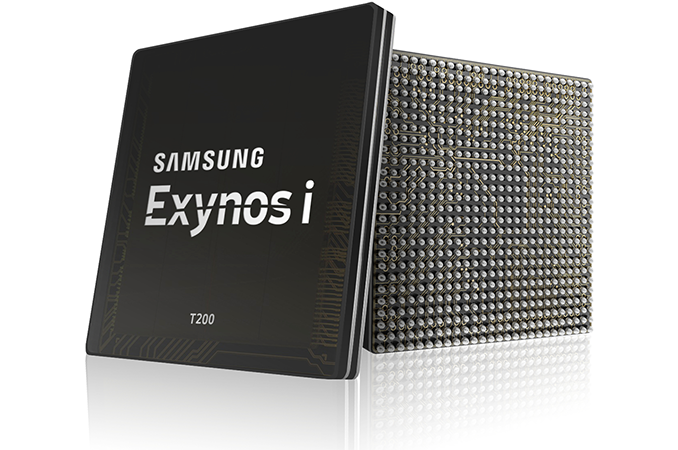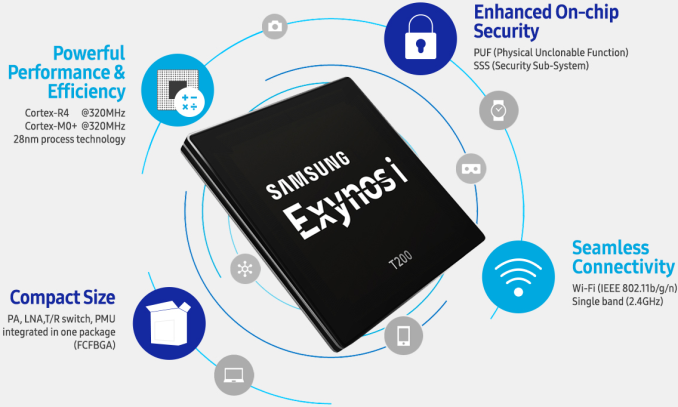Samsung Begins Production of Exynos i T200 SoC for Miniature IoT Devices
by Anton Shilov on June 23, 2017 1:00 PM EST
Samsung on Thursday said it had begun to mass-produce its first SoC for miniature IoT devices, the Exynos i T200. Aimed at devices that do not need a lot of compute power, but require ultra-low standby power consumption, the first Exynos i SoC integrates processing, connectivity, security and other capabilities.
The Samsung Exynos i T200 SoC uses one ARM Cortex-R4 CPU core and one ARM Cortex-M0+ CPU core for real time processing and microcontroller applications, with both cores running at 320MHz. For connectivity, the chip also contains a 802.11 b/g/n single-band (2.4 GHz) Wi-Fi controller and supports IoTivity protocol that enables interoperability between IoT devices over various protocols. In addition, Samsung’s Exynos i SoC has a security hardware block called the Security Sub-System (SSS) as well as a physical unclonable function (PUF) for secure data storage and device authentication.
The Exynos i T200 chip is made using Samsung’s “low power 28 nm HKMG” process technology, but Samsung does not specify which one. As for packaging, the SoC comes in an FCBGA form-factor.
Samsung did not indicate if and when it plans to start using the i T200 chip internally. Since Samsung also sells Exynos SoCs to third parties, it is possible that the Exynos i T200 ends up in devices made by other makers. As for pricing, the SoC uses a Cortex-R4 and a Cortex-M0+ cores, which are very small and optimized for low costs, therefore, it is unlikely that the Exynos i T200 will be expensive.
Related Reading:
Source: Samsung











16 Comments
View All Comments
rtho782 - Saturday, June 24, 2017 - link
The adverts turn shitty, the adblocker turns on, it's pretty simple.evanrich - Saturday, June 24, 2017 - link
this site has ads? I've had ublock on for yearsBrokenCrayons - Monday, June 26, 2017 - link
Because analytics -- so stop using the Internet for stupid stuff and you'll get adverts that are more intelligent looking.danielfranklin - Sunday, June 25, 2017 - link
28nm? Doesnt that kind of hurt the point?I guess there isnt anypoint putting this on the 20nm as it only offered higher density but dont they have two processes smaller than that again?
This feels like when a company doesnt quite commit, usually they end up losing the race, Eg. Intel in mobile.
I gusss they could be targeting this only at AC powered devices, but that seems like a lost opportunity.
kfishy - Friday, June 30, 2017 - link
Considering most microcontrollers are on older processes like 45nm, 65nm, or even 90nm and 130nm it's a bit of a moot point.FrankSchwab - Sunday, June 25, 2017 - link
Probably has as much to do with available space in the fab as anything.The leading edge processes will fill the fab building state-of-the-art memories and processors, where you can get top dollar for the parts. All the memories and processors will move out of the 28 nm fabs leaving them empty - think of the demand for 4 year old Samsung phone processors compared with the demand 4 years ago. These trailing-edge products fill those fabs nicely.